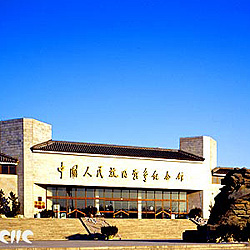
In just a month since July, more than 400,000 people from around the world have visited the Memorial Hall of Chinese People's War of Resistance Against Japan (1937-1945).
Located by the side of Lugouqiao (Marco Polo Bridge) in the southwest of the city, the memorial hall was opened on July 7, 1987, to mark the 50th Anniversary of the outbreak of the War of Resistance Against Japan.
The hall was built in three stages, with construction of major sections completed in 1987, 1997 and 2005 respectively.
Now the memorial hall has become one of the key destinations for "Red Tourism."
The memorial hall covers a total area of 30,000 square meters, with the main exhibition area itself covering 7,000 square meters.
As the only comprehensive memorial with material covering the war, the hall offers a chance to learn in more detail about the history of the war.
The recently-upgraded memorial hall includes a Main Exhibition Center, a Material Center and South and North Courtyards.
With the theme of "keeping history in mind and loving peace while ushering in the future," it comprises some 10,000 exhibits divided into eight sections. It features more than 800 cultural relics, 600 photos and about 40 graphs and charts. And among the many historical documents, 141 items have been made available to the public for the first time.
Standing prominently in the middle of the steps on the memorial's first floor is a two meter-high copper sculpture, "Awakening Lion." It symbolizes the age-old China, like an intrepid lion waking up from sleep after a long period of being attacked and enslaved. The lion also symbolizes the Chinese people's national spirit of rising up in defiance and being unwilling to yield.
Both the east and west halls exhibit many historical and cultural relics, precious documents and photos of the whole national resistance to the Japanese aggression army.
Among these are details of the great achievements of the Kuomintang army and of the patriotic generals on the various war fronts.
Lugouqiao Sculpture Park was also completed last month. It is located at the west side of Wanping.
Of the other travel destinations around the memorial hall, Lugouqiao Bridge is probably the most famous among tourists. The Italian traveler Marco Polo greatly admired this bridge some 700 years ago. It is also the site of the "July 7 Lugouqiao Incident." It was here that on July 7, 1937, that Japan began the full-scale war of invasion against China, and thus the War of Resistance Against Japan originated here. The bridge is just a 10-minute walk from the memorial hall.
Add: No 101, Wanpingchengnei Street, Fengtai District, Beijing.
Tel: 86-10-8389-3163
Opening time: 8:30 AM to 4 PM daily, except Monday.
Transport: Take Bus No.s 309, 313, 329 or 339 at Liuliqiao on the West Third Ring Road, and get off at Lugouqiao station.
Admission: 15 yuan (US$1.8) for adults and eight yuan for students.
The memorial hall is free for group tours from July 7 to September 20.
There are also many other "Red Tourism" destinations across China.
Xibaipo Revolutionary Site
Located 80 kilometers northwest of Shijazhuang, the capital city of North China's Hebei Province, Xibaipo was the village where Communist leaders established their base between 1947-1948.
Xibaipo also has a Revolutionary Memorial Museum.
Many train routes go to Shijiazhuang from Beijing. The journey is usually about two hours. From Shijiazhuang North Railway Station there are special bus routes to Xibaipo.
Jinggang Mountain
Located along the borders of Jiangxi and Hunan provinces, Jinggang Mountain is at the centre of the Luoxiao mountain range. In October 1927, the Autumn Harvest Uprising troops led by Mao Zedong marched to Jinggang Mountain and set up the first rural revolutionary base there.
The site is especially intriguing because of its historical past, bamboo forests and stunning waterfalls.
A 20-hour trip from Beijing West Railway Station will get you to this historic mountain.
Yan'an
Yan'an was one of the early headquarters of the Communist Party of China (CPC) and also the final destination of the Long March in the 1930s.
The Revolutionary Museum there has an interesting collection of exhibits displaying the period of Yan'an's historical importance. Exhibits here include old uniforms, weapons and photos.
Yan'an is most easily reached by plane. Trains run from Beijing West Train Station to Xi'an daily and can offer you a connection to Yan'an.
(China Daily August 12, 2005)
|

